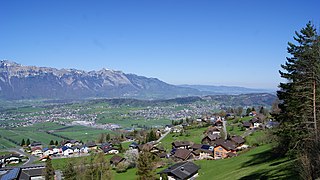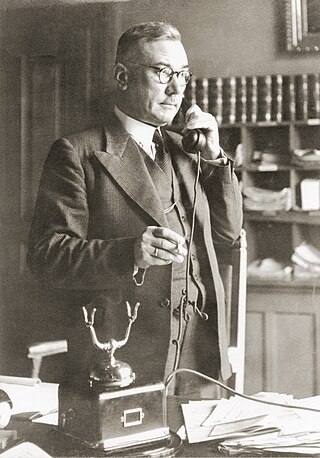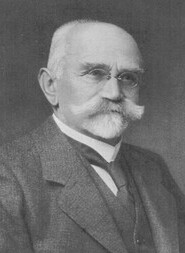
Political identity came to the territory now occupied by the Principality of Liechtenstein in 814, with the formation of the subcountry of Lower Rhætia. Liechtenstein's borders have remained unchanged since 1434, when the Rhine established the border between the Holy Roman Empire and the Swiss cantons.

The German National Movement in Liechtenstein was a Nazi party in Liechtenstein that existed between 1938 and 1945.

Mauren is a municipality in Liechtenstein that is situated in the north of the country. It has a population of 4,401. The Curta mechanical calculator was produced by Contina AG, in Mauren.

Alexander Frick was a politician from Liechtenstein who served as Prime Minister of Liechtenstein from 1945 to 1962. Frick is known for expanding Liechtenstein's foreign affairs and modernizing the country into a modern welfare state, while also serving over a period of economic boom in the country. He later went on to serve in the Landtag of Liechtenstein from 1966 to 1974 and as the President of the Landtag of Liechtenstein from 1966 to 1969.
Liechtensteiner Vaterland is the largest daily newspaper in Liechtenstein. Published by Vaduzer Medienhaus AG, it is the official newspaper of the Patriotic Union party.

The 1862 Constitution of the Principality of Liechtenstein was signed into law by Johann II, Prince of Liechtenstein on September 26 at Eisgrub, Moravia.

Gustav Schädler was a teacher and politician from Liechtenstein who served as Prime Minister of Liechtenstein from 1922 to 1928. He previously served in the Landtag of Liechtenstein from 1919 to 1922.

Franz Josef Hoop was a Liechtensteiner diplomat and politician who served as Prime Minister of Liechtenstein from 1928 to 1945. Hoop is best known for his efforts to retain Liechtenstein's neutrality and independence during World War II. Serving for seventeen years, he is the longest-serving prime minister in the country's history, ahead of his successor Alexander Frick by 79 days. He served under the reign of Johann II, Franz I and Franz Joseph II, making him the only prime minister to serve under three Princes of Liechtenstein consecutively.
The Christian-Social People's Party, often shortened to simply the People's Party, was a social liberal political party in Liechtenstein. It tended to be more popular in the Oberland, and supported closer ties with Switzerland as opposed to Austria. Founded in 1918, the Christian-Social People's Party and the Progressive Citizens' Party (FBP) were the first political parties in Liechtenstein.

Liechtenstein Homeland Service was a political party in Liechtenstein that advocated corporate statism and the abolition of party politics. Shortly after its founding, the party also moved towards Nazism. It merged with the Christian-Social People's Party to form the Patriotic Union in 1936.

The first Josef Hoop cabinet was the governing body of Liechtenstein from 6 August 1928 to 28 February 1936. It was appointed by Johann II and continued by his successor Franz I. It was chaired by Josef Hoop.
The 1939 Liechtenstein putsch, also known as the Annexation putsch was an unsuccessful coup d'état by the German National Movement in Liechtenstein on 24 March 1939 designed to provoke Liechtenstein's annexation by Nazi Germany.
Theodor Schädler was a politician from Liechtenstein. He was the leader of the German National Movement in Liechtenstein from 1938 to 1939, a Nazi Party that aimed to unify with Nazi Germany.

Albert Schädler was a Liechtenstein politician, physician, and historian. He served as the President of the Landtag of Liechtenstein from 1882 to 1886, and again from 1890 to 1919. A member of the prominent 19th-century Schädler family, he was well regarded as a physician and politician, and influenced the country's politics for decades.

Josef Karl Severin Schädler was a physician and political figure from Liechtenstein who served as the first President of the Landtag of Liechtenstein from 1862 to 1870.

The 1928 Liechtenstein embezzlement scandal was a scandal involving leading members of the Christian-Social People's Party, where it was revealed that they had embezzled funds from the National Bank of Liechtenstein for various speculative transactions. The scandal forced the government of Gustav Schädler to resign and early elections to be called.

Karl Schädler was an engineer and political figure from Liechtenstein who served in the Landtag of Liechtenstein.

The Rotter kidnapping was a failed organized kidnapping in Liechtenstein of Fritz Rotter and Alfred Rotter, German film directors and theatre managers of Jewish background, by Liechtenstein citizens sympathetic to Nazi Germany. The attack was additionally supported by five German nationals within the country.

Karl Freiherr Haus von Hausen was an Austrian noble and civil servant who served as the Governor of Liechtenstein from 1861 to 1884. Hausen was born into an Austrian noble family of Franconian origins, which was amalgamated under the title 'von Hausen' by Francis II in 1797.
















